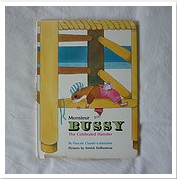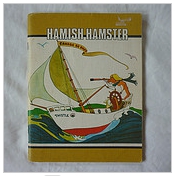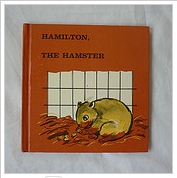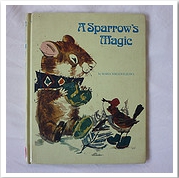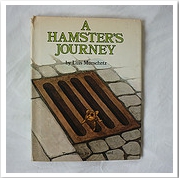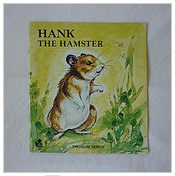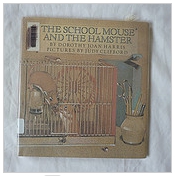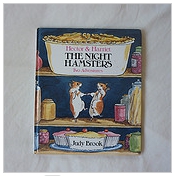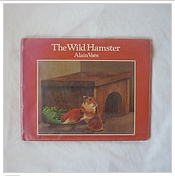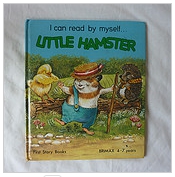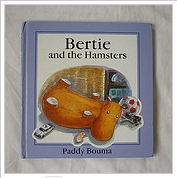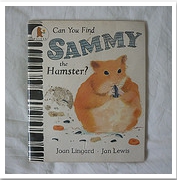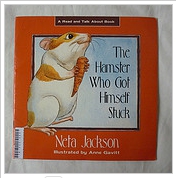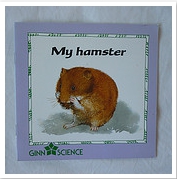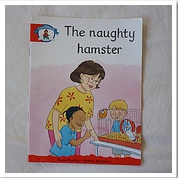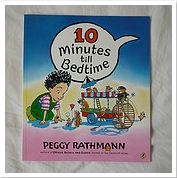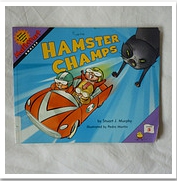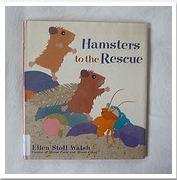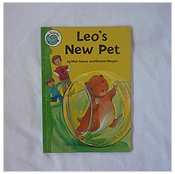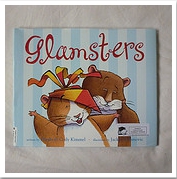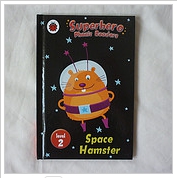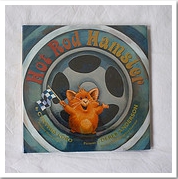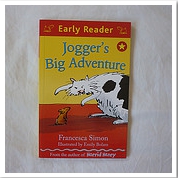Hamster Picture Books - Reviews
Little Rogues : Book Six “Golden Hamster” (Pictorial Children's reader) by Mollie Clarke (UK, 1940). The same book seems to be reprinted in 1954 and 1955 (this edition is probably from 1954).
This charming little illustrated storybook follows Golden Hamster as he tries to find a place that will accept him for who he is. 64 pages.
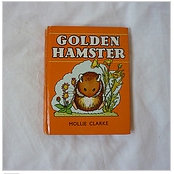
At the pet shop the other animals have not heard of Golden Hamsters, so they call him a “fat rat” – so he escapes from the pet shop. In the wild, the animals have not heard of Golden Hamsters, so they call him a “guinea-pig”. However, when they see how sad this makes Golden Hamster, they cheer him up by praising him when he uses his skills (digging, gnawing etc) to help the community and agree to humour him by calling him a Golden Hamster. Fortunately, eventually the little animal meets somebody who recognises him and finds a place where he can be himself and make real friends.
Humm the Singing Hamster by Catherine Bing (1961)
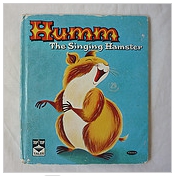
Where has Humm gone when he escapes? The sound of singing is coming from the kitchen...
J. Hamilton Hamster by Janet Konkle and Mary Gehr (1964)
This book combines black and white animal photographs (of a hamster, rabbit, kitten and hen) with block colour graphic illustration to tell a simple story about how even a materially wealthy life is not complete without friendship.
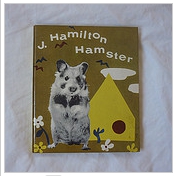
On each double-page there is a short paragraph of story, a photo and some graphics. Hamilton hamster starts the story with a new house and many possessions, although he is still keen to acquire even more grain in his cheek pouches. However, this begins to cause social faux-pas, which bothers the hamster as he accidentally offends his neighbours whilst dealing with his grain. However, after providing help to each of them, Hamilton and his animal neighbours end up as good friends and Hamilton feels richer than ever.
Gaspard/Kaspar/Humpy/Hannibal/Winslow the Hamster by Anne-Marie Pajot (1964)
This popular book was translated into several languages, hence the alternative names for the hamster in it. It was also republished in 1974 and in 1980. 'Humpy the hamster' is also by A. L. Ponder. Humpy the hamster may have been printed (or reprinted) later than the others, in 1974. It was also apparently reprinted as Winslow the Hamster (Animal Friends) by Rebecca Anders in 1978 and in 1987.
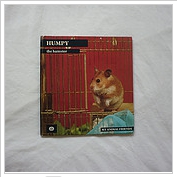
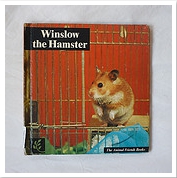
It may be worth noting that in 1972, popular song "Take It Easy" by the Eagles featured a man 'standing on a corner in Winslow'.
The Great Hamster Hunt by Lenore Blegvad and Erik Blegvad (1969)
Although this is not an ideal model of hamster ownership in some places, overall it is an entertaining story with top-quality illustration and has stood the test of time better than most.
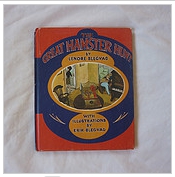
This book was republished in at least 1972 and 1976. As the title suggests, part of the plot involves hunting for an escaped hamster - but pleasingly, there is more to the story than just this device. The general standard of hamster care shown is quite high (despite the one error of judgement which leads to the escape, and a brief instance of putting two hamsters into the same cage which in reality would lead to vicious fighting) and the hamster custodians are shown having a strong bond to the animal or at least treating it with respect. However, this book does include the idea that hamsters are interchangeable and that one can be replaced by another that looks the same - although it is not clear in this book if the intent is deception or just that a similar-looking replacement is thought likely to soften the blow of a loss if the missing hamster is never found. Older children may be able to find the missing hamster hiding in the pictures during the hunt, but this might be too difficult for young children as the pictures are detailed and the hamster is well-hidden.
Where Did That Naughty Little Hamster Go? (10-Word Readers) by Patty Wolcott and Rosekrans Hoffman (1974)
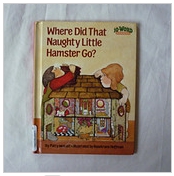
This book was published again in 1975, 1980, 1991 and in 1992.
The Hannibal Series by Raymond Howe (Ladybird Books) (UK, 1976-1982)
Ladybird books follow a set format for younger readers with 51 pages per hardback book and approximately 100 words per double page with a large colour illustration. The Hannibal books also have beautiful endpapers with nine detailed line drawings of Hannibal from the series, drawn by John Berry. There are six books in the Hannibal series: "Hannibal on the farm" (1976), "Hannibal on holiday" (1976), "Hannibal goes to school" (1978), "Hannibal and the pet show" (1978), "Hannibal and the nature trail" and "Hannibal runs away". "Hannibal on the farm" was also published by Happytime Books in 1979. In each book, Hannibal the hamster leaves his cage and explores alone, meeting a friendly mouse and various other animals and eventually returning to safety.
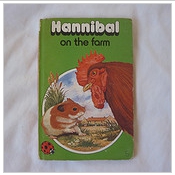
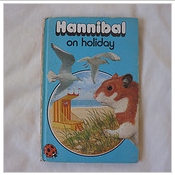
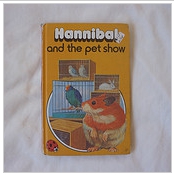
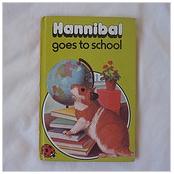
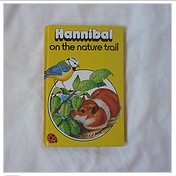
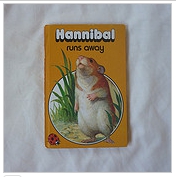
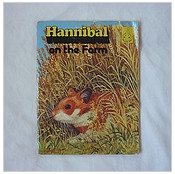
Hannibal is described as "inquistive, friendly and brave" and acts fairly realistically for a hamster. He is primarily interested in food and shelter but curious and prepared to explore, he gets startled easily but quickly forgets his fear and he is basically independent although there is a nod towards wanting to be with his owners (at least for the security of his extremely small and bare cage if not explicitly due to affection for them). Hannibal speaks with animals that he meets during his repeated trips out of his cage but he is a normal family pet rather than a 'talking hamster'. His escapes are all triggered by human failures but very little mention is made of any effects on his owners other than the inevitable happy reunion. Although the series are firmly storybooks, they contain a lot of 'stealth education' about the animals and places that Hannibal visits.
In "Hannibal on the farm" (1979) Hannibal's family go to housesit at their Uncle's farm for a week, taking Hannibal. After his cage is dropped, Hannibal finds himself loose in the farm grounds. His quest to find safety and vaguely head back towards his owners over the course of several days is punctuated by a constant stream of helpful animals who advise him on places to shelter and the dangers of predators. In particular, Harvest Mouse, Gosling and Sheepdog explain their lives.
In "Hannibal on holiday" (1976) the family take Hannibal to a caravan site at the beach but his cage is left open, so Hannibal goes exploring. Teaming up with a mouse who lives in the Punch-and-Judy hut, Hannibal ventures as far as the sea (where the tide gives him a shock) and meets Crab and Turnstone before arranging a cunning plan for his own recapture.
"Hannibal and the pet show" (1978) begins with Hannibal and White Mouse being accidentally freed when the table holding their cages at the Pet Show collapses. Whilst foraging for spilled seeds they meet a variety of pets, several of whom talk longingly of their species' ancestral homes (Hannibal replies that "Hamsters have lived with man for so long now that we cannot remember ever being wild creatures"). Then the duo come across another uncaged animal - Alley Cat - and peril ensues.
When "Hannibal goes to school" he quickly realises that it is too dangerous to stay in the classroom because of School Cat. Instead, he hides in the warm coal store with Boilerhouse Mouse and Swallow and learns about migration to Africa. This book has slightly more overt humour than the rest of the series, with much being made of the coal dust making Hannibal and Boilerhouse Mouse appear black (which sits rather uneasily in view of the rest of the plot) and a final twist involving bean-bag beans.
The Benjamin Series by Alan Baker (1978-1990)
The Benjamin books are primarily picture books for younger readers or to be read with a child by an adult. There are six titles exploring the actions of Benjamin the glasses-wearing brown hamster: Benjamin and the Box (1978), Benjamin Bounces Back (1978), Benjamin's Book (1983), Benjamin's Dreadful Dream (1980), Benjamin's Balloon (1990) and Benjamin's Portrait (1987/88). Each follows Benjamin's train of thought as he goes through a series of different approaches to a problem and finally succeeds. The illustrations are simple but beautifully detailed and provide lots of things to discuss as everything drawn is relevant - the entire story is told using the pictures, to which the words are only really captions adding extra insight into the hamster's motivations. Whilst Benjamin is an endearing character he could easily be another type of mysteriously able animal without changing the books at all, however he does present a positive image of a hamster as a being with thoughts and desires of its own.
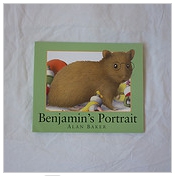
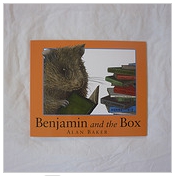
Benjamin's Portrait follows Benjamin painting a picture of himself. There are several unfortunate accidents with paint, leading to Benjamin becoming covered in coloured patches, but at the end he is happy with his picture - although he thinks of an easier solution for next time on the last page.
In Benjamin's Box a large wooden chest is presented. Benjamin wants to open the chest and find out what is inside, trying tools, a flamethrower and even magic. At the end it turns out that another hamster was locked inside the chest (which doesn't have any visible airholes...) but after sniffing each other Benjamin joins the second hamster in the closed box and they hang up a "Do Not Disturb" sign together.
My Hamster, Van, (Celebration Press Ready Readers, Stage 2, Book 6) by Florence Beem and Elfrieda H. Hiebert (1981)

Also published in 1996 and 1998.
The Tales of the Riverbank Series (Mark 2) by Dave Ellison (1982)
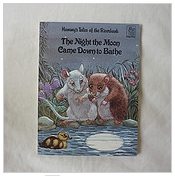
Following the success of the Tales of the Riverbank live-action rodent-based TV series in the 1960s, a second set of episodes called "Hammy Hamster's Adventures" were made. This book dates from 1982 and is a spin-off from one of these later versions.
Link-up Basic Readers: Emma's Hamster (Link-up story club) by Margaret Donaldson, Jessie Reid and Joan Low (1983)
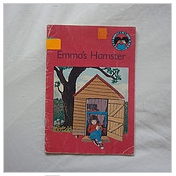
Roland Rat and friends (BBC TV) (1984-1987)
Roland Rat was a puppet used to host children's TV in the mid 1980s. He became a successful brand with a cast of companion rodents and his own TV shows, books, merchandise and even 'recorded' an album. One of the recurring rodent sidekicks was Errol the hamster, a dour Welsh production assistant.
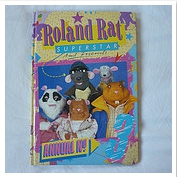
Errol the hamster is described here on the ongoing "Ratfans" fan website and even has his own current Facebook page.
Hide, Hamster, Hide! and other stories by Helen Piers (1984)
This book is a bind-up of four books which were also published individually in 1984. Each is described as "A Magnet Book" although they are published by Methuen Children's books (another source also lists the individual books as 'Snowball' books). "Hamster is Hiding" by Helen Piers is the first book in the combined edition, taking up 24 pages. The other stories are Goat in the Garden, Puppy in the Park and Kittens in the Kitchen. Each story is illustrated with full page and double-page colour photographs showing staged scenes with real animals and household props. The text of each tale builds up with cumulative repetition ('12 days of Christmas' style) then rounds up with a short finale.
In the hamster story, Hugga Mugga the hamster has escaped from his cage and is being stalked by the cat - he moves from hiding place to hiding place (mostly hiding under toys, but also in a shoe and in a bag of sweets), with the cat following close behind and repeating the ever-increasing list of places that the hamster has not been found. There is a small amount of drama mid-list when the cat finds Hugga Mugga but he runs away successfully and continues hiding, but it does not appear to have concerned him as at the end he finds a safe place (a fleece pocket, maybe a child's dressing gown?) and dares the cat "Here I am, cat! Catch me now if you can!".
The Hit of the Party by Franz Brandenburg (1985)
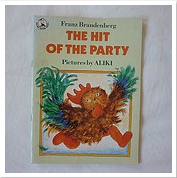
Two young children have been invited to a fancy dress party, but the brother teases his sister that his costume is superior to hers - he will be dressed a fine rooster with coloured wing and tail feathers whilst she will only be a brown hen. Soon, it is found that their hamster has escaped and the loss distracts both children. With only moments to go before they need to give up their hamster-search to go to the party, the hamster is found - snug in a bed made of chewed-up coloured feathers! The children attend the party with their more equal costumes and are declared the joint 'Hit of the Party' together.
Illustrated by Aliki.
Hamster and Gretel (An Animal Tales Pop-Up Book) by Keith Moseley (1989)
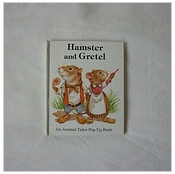
This short book retells the well-known fairytale of "Hansel and Gretel". Other than changing the name of one character and putting anthropomorphic rodents in the pictures, there isn't much to say about it - the story is written simply and exactly the same as any usual retelling. The pop-ups are fun, but they just make the drawn scenes slightly 3D (and in my copy, do not work 100% reliably).
Houdini, the Disappearing Hamster by Terence Blacker and Pippa Unwin (1990)
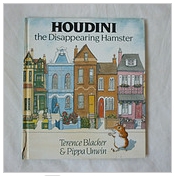
This book describes itself as "a game and a story".
A Red Fox picture book, republished in 1991 and 1999. Also published in an American edtion in 1990, named "Herbie Hamster, Where Are You?"
The Tales of the Riverbank Series (Mark 3) by Dave Ellison (1993)
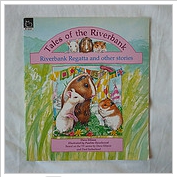
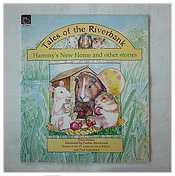
In 1993, Scholastic Publications Ltd. published three children's books based on the again-revamped (Further) Tales of the Riverbank brand and illustrated by Pauline Hazelwood. These were: Riverside Regatta and other stories, Hammy's New Home and other stories and one other of unknown title (possibly the Tales of the Riverbank Activity Book).
Harry is Gone!: A Hide and Seek Story by Sarah Chisholm and Michelle Neavill (1992?4?)
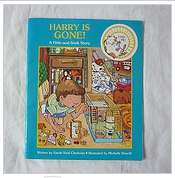
This is sometimes listed on the internet as published in 1959, this is not hte case, it appears to probably come from one source having 1959 as the dafault if there is no date?
The Adventures of Hammy the Hamster by Richard Alan Savage (1996)
This is now a scarce hamster book.
Can't Catch Me! (A Little Readers Book) by Jillian Harker (1997)
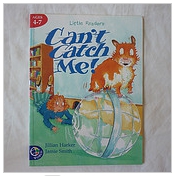
Published by World International Ltd.
Hamster and Cheese by Colleen A. F. Venable (1997)
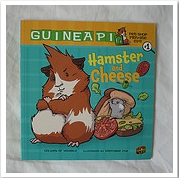
A story from an ongoing series about a detective guinea-pig and her hamster sidekick.
The Harriet Series by Deborah Inkpen (1998-2002)
There are three books in this series: Harriet (1998/01), Harriet Cast Adrift (2000) and Harriet and the Fat Fairy (2002). All are written by Deborah Inkpen and published by Hodder Children's Books.
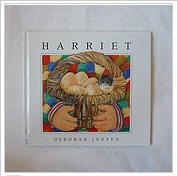
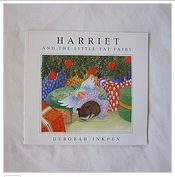
Promise you won't be cross (Blue bananas) by Bel Mooney and Margaret Chamberlain (1999)
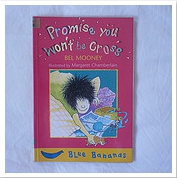
Published by Heinemann.
What Joe Hamster finds (Sunshine. Early Fluency, Level K) by Sydnie Meltzer Kleinhenz (2000)

This is now a scarce hamster book.
A Home for the Hamsters (Great Smoky Mountains Storybook series) by Larry Burkett (2000)

An American book, illustrated by Terry Julien and published by Moody.
The Lola series by Carl Norac and Claude K. DuBois (2000-2002)
There are three books in this series about a young hamster-toddler called Lola and her family: I Love You So Much (2000/02), Hello, Sweetie Pie (2001/02/03) and I Love to Cuddle (2002/03/04).
Little Hamster and the Great Flood by Caroline Jayne Church (2001)
This book retells the biblical story of Noah’s Ark from the viewpoint of the new character Little Hamster, who scurries into each double page in the form of a plush toy hamster on a retracting string.

Because of the physical design of the book to include the plush hamster, this is a board book with only a few fully-illustrated double-page spreads to tell the whole story of the Flood/Noah's Ark.
I initially found it unreasonably irritating that three sheep are pictured all the way through (given that "the animals went in two by two"), but this is actually Biblically accurate as "7 of every kind of clean animal" were allowed onboard the Ark.
In my copy, it is quite hard to get Little Hamster to return properly - the idea is that the reader walks the toy up the provided pictures of paths/gangplank/etc by hand and then the hamster scampers back to the rest position when released, but my hamster toy rolls wildly with an alarming noise as it retracts and usually ends up falling off the book altogether. Having said this, the mechanism seems very robust and able to stand up to rough pulling, the hamster is well-made and well attached and the strong cord is short enough not to be an obvious hazard.
Animal Stories - Clive the Hamster by Alan Gilbey (2001)
This book is part of a set of 16 books to accompany the animated series "Animal Stories". Each episode of Animal Stories features a rhyming story about a different animal overcoming a natural set-back which is a trait of its species. Clive the Hamster is jealous and selfish, but worst of all he is a thief!
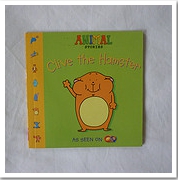
The "Clive the Hamster" episode of Animal Stories can be viewed on You Tube here.
Clive is envious of the nice things which other animals have and so he takes them and hides them in his cheek-pouches. When he is eventually laid low by being too ambitious in his theft, it turns out that not only is everyone very disappointed in him, but he was only stealing 'from himself' as all the items were being gathered to throw a party for Clive. Fortunately Clive learns from this and so the animals forgive him and the party can go ahead after all.
Kipper and Roly by Mick Inkpen (2001)
This book is part of a popular ongoing series about Kipper the dog. It is possible that the hamster from this book cameos briefly in other books in the series.
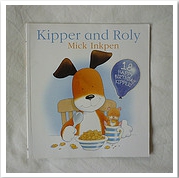
Published by Hodder Children's, republished in at least 2007 and 2008.
Harry Hamster and His Bedtime (Play Pals) (2001)
This now-scarce board book is contained within a furry zip-up cover in the shape of a hamster's face. This now-inactive shop listing describes it with pictures.
Looking after Murphy by Jamie Rix and John Bendall-Brunello (2002)

Published by Hodder Children's.
This heavily-illustrated storybook describes what happens when Murphy the hamster goes to stay at Granny Lally's house whilst his two child owners are on holiday.
Unfortunately, although I would love to recommend this book because of the beautiful illustrations, the actual story has many many issues.
The background of the story before the hamster gets involved sets up that Granny Lally habitually lies and often also acts in ways that would be seen as pretty antisocial were they not aimed at children (and thus cute), and that the children are fully aware of this but still humour her "little ways" politely (not having much choice and also being well-mannered). Sadly, Granny Lally is also inevitably a very poor hamster-keeper (she is well-meaning, but her efforts are seriously flawed) and prefers not to take any responsibility for her actions. Although the initial holiday-stay ends up ending without fatality basically by chance, for some reason the family choose to allow her to hamster-sit again (despite having some evidence of her failures) and the book ends with yet another illustration of a 'cute' yet highly inappropriate and dangerous example of how not to look after hamsters.
Some of the most glaring problems with hamster care in the book include (but are not limited to): keeping hamsters in a dolls-house rather than a cage, carrying hamsters loose out of the house and when there is a cat nearby, giving hamsters boiled sweets, sitting a hamster on a tap over a deep bath of water, having a hamster loose on a worksurface whilst cooking, keeping two hamsters in the same cage, and uncontrolled breeding (including keeping the litter together to breed further). Although the book presents Granny Lally's lying in a relatively poor light, all of the hamster issues are shown as perfectly fine, or even adorable and aspirational.
The Hamtaro Series by Ritsuko Kawai (Japan, mainly 2003-2004 in UK)
Hamtaro follows the adventures of the hamster Hamtaro as he encounters the daily life of his girl-owner and secretly escapes from his cage to travel outside to the 'Ham-Ham Clubhouse' and meet up with several hamster friends. Hamtaro began as a manga, but gained international popularity when it was made into an anime series focusing on the Ham-Hams (which can be bought on Region 1 DVD). The global success of the brand means that there are many spin off products including books and an official website (going to www.hamtaro.com gives you a song so this link is to the index page just beyond, sound is used throughout the website). The Hamtaro brand is seemingly unique amongst hamster series in having a non-fiction pet care book as well as fiction titles and is also noteable for the wide range of onomatopaeic words used for the sounds which the hamsters produce.
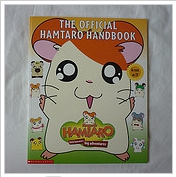
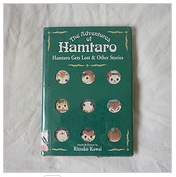
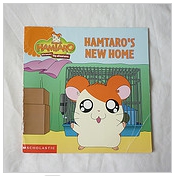
The "Adventures of Hamtaro" hardbacked books have three volumes: Vol 1, Vol 2 - Hamtaro Gets Lost & Other Stories (2003) and Vol 3. Inside, short stories are told in graphic form, each 'chapter' covering an event in the life of Hamtaro as a pet - such as meeting another caged hamster, being let out to roam in the house or the worrying day when Hamtaro was accidentally bagged up with the household rubbish. The other Ham-Hams from the animated series do not feature, although in Volume 2 Hamtaro is (age-appropriately) used as a stud hamster and after a night snuggled up with his 'new friend' in his nestbox she produces a litter of babies to which he is the proud father. The book is especially notable for having a fold out double page spread containing a complex colour picture to search for Hamtaro, and the outer dust cover hides a much more brightly illustrated hardback cover but has nine holes cut out through which hamsters can be seen showing through from the picture beneath.
Billy and Belle by Sarah Garland (2004)
Whilst their mother goes into hospital to have a little baby brother, Billy must take his little sister Belle to school - where it is Pet Day.
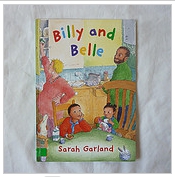
Hannibal's noisy day (Reading Corner) by Anne Adeney and Christina Bretschneider (2005)
A humourous story dealing with the conflict between a nocturnal pet and a household of humans who are awake during the day but want to sleep at night.
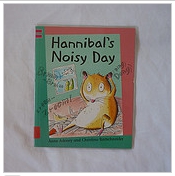
During the day poor Hannibal is trying to sleep, but one noise after another wakes him up - everything from a crying baby, traffic, schoolchildren wanting to play and adults talking. After snatching interrupted rest he finally gets to sleep at tea-time - ready to wake up refreshed and run on his noisy wheel once all the humans are sleeping, waking them all up in return!
Published by Franklin Watts.
Monster! by Angela McAllister and Charlotte Middleton (2005)
This book would be a great place to start teaching a child the responsibilities of pet care and empathy for animals as living creatures - ideally before providing an "educational" hamster that might end up neglected.
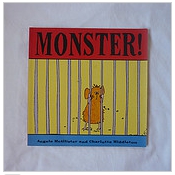
Published by Simon & S.
This excellent hamster story follows the fate of a hamster bought as a gift for a small boy who would really much prefer a larger and more exciting pet. After giving the hamster an exciting name - Monster - and attempting to teach it tricks, the boy swiftly loses interest and Monster is neglected. After a heart-rending period in which eager-to-please Monster is very lonely and begins to run out of water and food, there is a strange turn of events, which rescues Monster and teaches the boy a sharp lesson in empathy. Fortunately, the lesson sinks in and the boy begins to pay much more loving attention to his now-renamed hamster before any permanent damage is done.
The Little Hamster (Board Book) by Elly Van Der Linden and Debbie Lavreys (2007)
Despite the title and cover, this book has almost nothing to do with hamsters at all
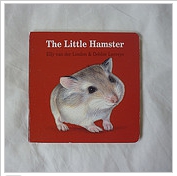
Each double-page of this short board book meets a different animal. The meetings are fairly shallow (they do not really touch on anything specific to the type of animal, the particular animal, or how to interact with that type of animal), and only one is with a hamster. There is no over-arching storyline.
Carry Along Pets: Hamster by Fiona Hayes (USA, 2008)
This short board book illustrated by Kate Davies shows the everyday life of a hamster as it stores food, nests, runs in a wheel and so on. The book is shaped like a hamster and comes in a heavy duty cardboard "carry case" which opens and closes with velcro, so that the book itself can be treated as a surrogate hamster pet and carried around.
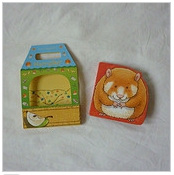
This book has a lot of potential amusement value from the dual role of hamster toy and hamster story. A child who becomes familiar with the actions of the hamster in the book would also be ready to find out more and look after their own real hamster when they are older, as the main concepts of what hamsters like to do and eat etc would already be familiar to them.
The Project X Reading Scheme by Oxford University Press (2009-2010)
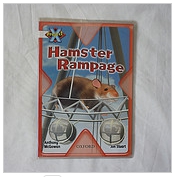
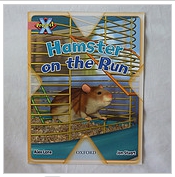
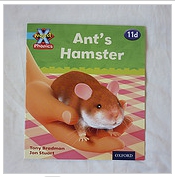
These books are part of the Project X reading scheme, there are hamster books in two different 'series' within it.
The full details of these books are: 1) Project X: Journeys: Hamster Rampage by Anthony McGowan and Jon Stuart (2009) 2) Project X: My Home: Hamster on the Run by Alex Lane and Jon Stuart (2009) 3) Project X Phonics Blue: 11d Ant's Hamster by Tony Bradman (2010)
Hamster Rampage is not the first place to consider the idea of the London Eye as a giant hamster wheel, as this satirical image from 'Nature Notes' in the Times, 19th Feb 2000, shows.
The Zhu Zhu Pets Series (2010)
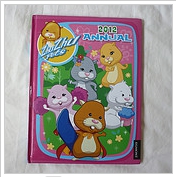
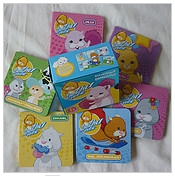
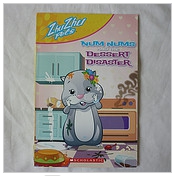
Including “Meet the Zhu Zhu Pets (with stickers)”, “Zhu Zhu Pets: Happy Hamsters!”, “Zhu Zhu Pets: Furry Friends!”, "Mr. Squiggles' Halloween Party", “Num Nums and the Dessert Disaster”, “Zhu Zhu Pets Jumbo Coloring & Activity Book: Hamster Invasion”
The Fujimini Adventure Series by Eileen Wacker (2010-2011)
Hamster-related titles in this series include: Green Hamster & the Quest for Fun (2010/2012) and Pink Hamster & the Big Birthday Surprise (2011). The Fujimini series have an Asian-inspired island setting with anthropomorphic hamsters, pandas and so on. They are apparently particularly popular in Hawaii!
Holly Hamster: All Aboard! by Jo Joof (UK, 2011)
This board book contains a hamster-shaped squeaker which appears through a cut-out on every page, allowing the reader to follow the hamster character through the unfortunately dangerous and irresponsible story.
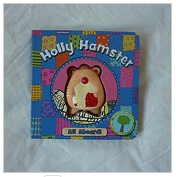
The back of this book describes it as "a short story with an important message and a squeaky Holly Hamster" - I would say that this is half right. The squeaking toy is definitely a fun feature but I am not sure what the "important message" is supposed to be - possibly that if you don't turn the tap off, the sink will overflow?
I really wanted to recommend this book to young children because of the squeaky toy, but the story focuses on putting hamsters in a sink full of water in a boat made out of newspaper - which is an incredibly bad idea and really not something that any small child should ever be encouraged to do. At best a pet hamster treated this way might bite, escape or catch cold, but much more likely it would drown horribly in the steep slippery sided sink full of deep water as it would not be able to climb out or keep itself afloat for long.Secondarily, I am also a little confused why all the apparently 'real' hamsters in the story have coloured fabric patches sewn to them, and also concerned that the hamsters are shown playing on a wheel with open rungs which they could easily break a leg on. Three Syrian hamsters are also shown living together in a shared cage but it is possible that they are supposed to be young littermates given the age of the intended audience for this book - but still quite a catalogue of fail for a book that is only 9 pages long.
No More Hitting for Little Hamster! by Bernette Ford and Sam Williams (2011)
Little Hamster learns that no-one wants to play with hamsters who hit!
Toy Story: A Pet Problem (Little Golden Books) by Disney-Pixar (2011)
This book tells the story of the "Toy Story" brand characters when their child brings home the class hamster to look after. Will the toys be displaced, or learn to love their new neighbour?
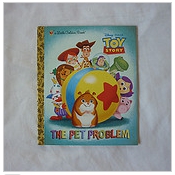
Unsurprisingly, after a fairly low-peril hamster escape and recapture showcasing all the characters' particular abilities, the Toys end up feeling reassured.
This focus of this book is on the franchise characters rather than the hamster (who spends nearly the whole time in the middle distance) - it is a gentle, entertaining story but it would work nearly as well if it was a new and particularly attractive helium balloon that had floated off rather than a hamster wandering loose. The book itself is fairly pretty, with vintage-style illustrations and shiny gold foil binding the spine.
A Place to Call Home by Alexis Deacon (2012)
Illustrated by Viviane Schwarz. It is somewhat unclear if these animals are supposed to be hamsters or another kind of rodent (their species is not defined in the book), but as they have no tails and have plausible hamster size and colouring, they could be.
That’s Not My Hamster! (Usborne Touchy-Feely Books) by Fiona Watt (2012)
This picture book contains textured panels for babies to feel. It is part of a series of similar "That's not my....It's too....!" textured books each focusing on a different animal.
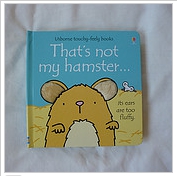
This book is durable, well-made and attractive. The premise is very simple but well-executed. Several incorrect hamsters are sampled, each with a different textured fabric body-part, until eventually the reader's own hamster (with "soft belly fur") is located.
Although I very much like this book, I think it is slightly more dubious than related titles about eg: "That's not my tiger" because toddlers are more likely to have a hamster in their house where they could get accidental unsupervised access to the cage - so it could be argued that encouraging them to see eg: how soft a hamsters' ears are, especially by reaching into the nest or touching a nose through the bars, is asking for a toddler to get bitten/family hamster to then escape.
Flying Like Flittermouse (Bottlenose Bay Series) by Jan Fearnley (2013)
A gorgeous book with a lot of detail in the pictures and a fold-out map of Bottlenose Bay inside the front cover.
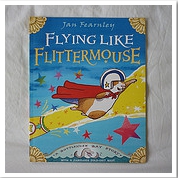
Etsuko the "Happy Hamster of Loveliness, who runs the tea-shop" is dazzled by the flying ability of customer Flittermouse, a bat. Despite her ingenuity and help from her friends her first attempts to fly are not successful - pear-shaped tea-shop hamsters are not terribly aerodynamic - but eventually Etsuko achieves her dream with some help from her friends and a light aircraft. The story is very positive about having dreams and going for them even if they are "silly dreams" and even if you are otherwise a "sensible" person.
Although many of the activities Etsuko engages in would be dangerous for a pet hamster, Etsuko is very anthropomorphic and treated as a person who happens to be in the shape of a hamster far more than as an actual hamster, making it relatively clear that the story is not a set of recommendations for actual hamster care (adult supervision should hopefully be able to prevent young children trying to give their hamster the supposedly-enriching experience of zooming through the air and prevent them accidentally discovering that real hamsters do not end up so blithely unhurt after a long fall)
Kristie's Excellent Adventures: Laundry Day by Geri McNeely Schultz (2013)
Illustrated by Vince Bertolami and published by Windy City
Archie and Frisbee by Anne Rooney and Ann Johns (2013)
An attractive but not-especially-original book about a child who takes home the class hamster and has it escape.
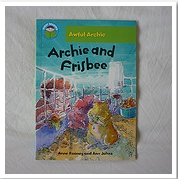
This book is the size and shape of a non-picture book, but thin. It tells the brightly-illustrated story of Archie as he is on his best behaviour so that he can take home the class hamster Frisbee, and then the inevitable issues that occur after that takes place (Frisbee escapes through Archie's inexperience/negligence, and the parents decide to replace Frisbee with an identical hamster, but on return to the classroom Frisbee re-emerges so the teacher decides to keep both hamsters together from then on). The book ends happily but would be much better from a hamster care perspective without the final page - when Frisbee is held up to his old cage containing the imposter hamster his look of horror is very apt, but the following idyllic 'Frisbee can have a new friend' scene with the two hamsters shown standing with their arms around each other's shoulders is pure fantasy.
A Start Reading (Green Band 5) book by Wayland
